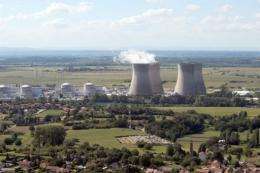Today's plants far safer than Fukushima: US expert

Today's nuclear reactors are "much safer" than the Japanese plant damaged in this year's earthquake and tsunami, a US expert said Thursday, citing dramatic improvements that could prevent similar disasters.
The first of Fukushima Dai-ichi's six nuclear reactors came online in 1970, a full nine years before the Three-Mile Island crisis in the United States and 16 years before Chernobyl, the world's worst nuclear disaster.
"The Fukushima plants were early plants, and so... more modern designs would be much more robust in their capability to deal with the situation" that Japan faced, said former US Nuclear Regulatory Commission chairman Richard Meserve.
"Plants are much safer in their designs today."
On March 11, a 9.0-magnitude quake rocked Fukushima, and the resulting 14-meter (46-foot) ocean wave drowned the plant, knocking out the power supply, the reactor cooling systems and back-up diesel generators.
The resulting meltdown of reactors forced the evacuation of thousands of people and the banning of local farm produce. Six months on, engineers are still fighting to stop radiation leaking out.
Meserve said Fukushima's designers should have looked at historical data which showed a similar-sized tsunami hit the area in the year 869. The plant, he said, was designed to be able to accommodate a 5.7-meter tsunami.
Meserve, an advisor to the UN's International Atomic Energy Agency, said plant developers in the United States always look at "what's the maximum probable event in that environment," and design accordingly.
"It appears that this was not the case with regard to the Fukushima plant," he said.
While its layout and design would not be considered by today's builders, Meserve stressed that Fukushima, for its day, was not seen as unsafe.
Designs have improved substantially in large part because engineers are "continuously learning from what has happened in the past and making sure that you learn from experience so that history is not repeated."
Aside from advances like high-quality construction and passive safety systems that override human failures, today's designers incorporate what's known as "probabalistic risk assessment," which looks at the likelihood of events that could cause damage.
(c) 2011 AFP




















